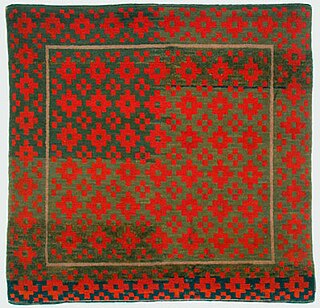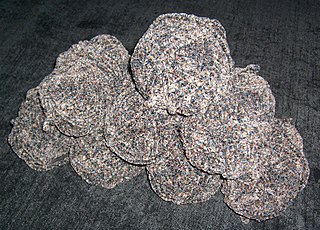
Kidderminster is a market town and civil parish in Worcestershire, England, 20 miles (32 km) south-west of Birmingham and 12 miles (19 km) north of Worcester. Located north of the River Stour and east of the River Severn, in the 2021 census, it had a population of 57,400. The town is twinned with Husum, Germany.

A carpet is a textile floor covering typically consisting of an upper layer of pile attached to a backing. The pile was traditionally made from wool, but since the 20th century synthetic fibers such as polypropylene, nylon, or polyester have often been used, as these fibers are less expensive than wool. The pile usually consists of twisted tufts that are typically heat-treated to maintain their structure. The term carpet is often used in a similar context to the term rug, but rugs are typically considered to be smaller than a room and not attached to the floor.

Tibetan rug making is an ancient, traditional craft. Tibetan rugs are traditionally made from Tibetan highland sheep's wool, called changpel. Tibetans use rugs for many purposes ranging from flooring to wall hanging to horse saddles, though the most common use is as a seating carpet. A typical sleeping carpet measuring around 3 ft × 5 ft is called a khaden.

A Persian carpet or Persian rug, also known as Iranian carpet, is a heavy textile made for a wide variety of utilitarian and symbolic purposes and produced in Iran, for home use, local sale, and export. Carpet weaving is an essential part of Persian culture and Iranian art. Within the group of Oriental rugs produced by the countries of the "rug belt", the Persian carpet stands out by the variety and elaborateness of its manifold designs.

Chenille is a type of yarn, or the fabric made from it. Chenille is the French word for caterpillar whose fur the yarn is supposed to resemble.

Rug hooking is both an art and a craft where rugs are made by pulling loops of yarn or fabric through a stiff woven base such as burlap, linen, or rug warp. The loops are pulled through the backing material by using a crochet-type hook mounted in a handle for leverage. In contrast latch-hooking uses a hinged hook to form a knotted pile from short, pre-cut pieces of yarn.
An oriental rug is a heavy textile made for a wide variety of utilitarian and symbolic purposes and produced in "Oriental countries" for home use, local sale, and export.

Tufting is a type of textile manufacturing in which a thread is inserted on a primary base. It is an ancient technique for making warm garments, especially mittens. After the knitting is done, short U-shaped loops of extra yarn are introduced through the fabric from the outside so that their ends point inwards.

Anatolian rug or Turkish carpet is a term of convenience, commonly used today to denote rugs and carpets woven in Anatolia and its adjacent regions. Geographically, its area of production can be compared to the territories which were historically dominated by the Ottoman Empire. It denotes a knotted, pile-woven floor or wall covering which is produced for home use, local sale, and export, and religious purpose. Together with the flat-woven kilim, Anatolian rugs represent an essential part of the regional culture, which is officially understood as the Culture of Turkey today, and derives from the ethnic, religious and cultural pluralism of one of the most ancient centres of human civilisation.

A knotted-pile carpet is a carpet containing raised surfaces, or piles, from the cut off ends of knots woven between the warp and weft. The Ghiordes/Turkish knot and the Senneh/Persian knot, typical of Anatolian carpets and Persian carpets, are the two primary knots. A flat or tapestry woven carpet, without pile, is a kilim. A pile carpet is influenced by width and number of warp and weft, pile height, knots used, and knot density.

Azerbaijani carpet is a traditional carpet (rug) made in Azerbaijan. The Azerbaijani carpet is a handmade textile of various sizes, with a dense texture and a pile or pile-less surface, whose patterns are characteristic of Azerbaijan's many carpet-making regions. Traditionally, the carpets were used in Azerbaijan to cover floors, decorate interior walls, sofas, chairs, beds and tables.

John Brinton was an English carpet manufacturer and a Liberal politician.
A Pakistani rug, also known as Pakistani carpet, is a type of handmade floor-covering heavy textile traditionally made in Pakistan and is used for a wide variety of utilitarian and symbolic purposes. Rug/carpet weaving is an essential part of Pakistani culture and Pakistani art.
Parker Knoll is a British furniture manufacturing company, formed in 1931 by British furniture manufacturer Frederick Parker and Willi Knoll, a German inventor of a new form of sprung furniture. With roots in the manufacture of high-quality furniture, the brand concentrated on mass-market products from the 1930s to the 1990s. The company was listed on the London Stock Exchange in 1950, but taken private in 2004. After financial difficulties, it was acquired out of administration by Sofa Brands International.

Tai Ping Carpets International Ltd. is a global custom carpet company serving the architect and design community. Based in Hong Kong, Tai Ping Carpets operates flagship showrooms in New York City, Shanghai and Paris, as well as proprietary factories, design studios, and showrooms in 100 countries, over four continents.

Mohawk Industries is an American flooring manufacturer based in Calhoun, Georgia, United States. Mohawk produces floor covering products for residential and commercial applications in North America and residential applications in Europe. The company manufacturing portfolio consists of soft flooring products, hard flooring products, laminate flooring, sheet vinyl and luxury vinyl tile, natural stone and quartz countertops. In Europe, the company also produces and sells insulation, panels and mezzanine flooring. The company employs 43,000 people in operations in Australia, Brazil, Canada, Europe, Malaysia, Mexico, New Zealand, Russia and the United States. A Fortune 500 company, Mohawk is the worlds largest flooring manufacturer.
Axminster Carpets Ltd is an Axminster, Devon based English manufacturer of carpets, particularly the same-named Axminster carpets.
Kapotex Industries is a manufacturer of woolen & other blends of carpet yarns used in the production of machine-made, hand-made rugs & broadloom wall-to-wall carpets. Headquartered in Mumbai, Maharashtra, it specializes in manufacturing yarns for Axminster Weaving, Face-to-Face Weaving, Wilton Jacquard Weaving, and Tufting Broadloom Carpets & Rugs including mechanized hand tufted & pass tufted carpets and rugs.
Roger Oates Design is a British company that designs, manufactures and retails flooring, fabric and interior products. The company is best known for Venetian Flatweave, a narrow width wool floorcovering usually fitted as a stair runner.

The Oriental Carpet Manufacturers (OCM) was a London-based company involved in the production of, and trade with, Oriental carpets. Established in 1907/8 in Istanbul, the company set up and controlled their own carpet manufactures in the central Anatolian region around the town of Konya, and from 1911 onwards, in the Hamadan Province in northwestern Iran. In 1983 it was sold, and merged with one of its former affiliates, the Eastern Kayam Company. From 1924 until 1948, OCM was led by Arthur Cecil Edwards, who, after retiring, wrote a text book on Persian Carpets, which is still in print today.














